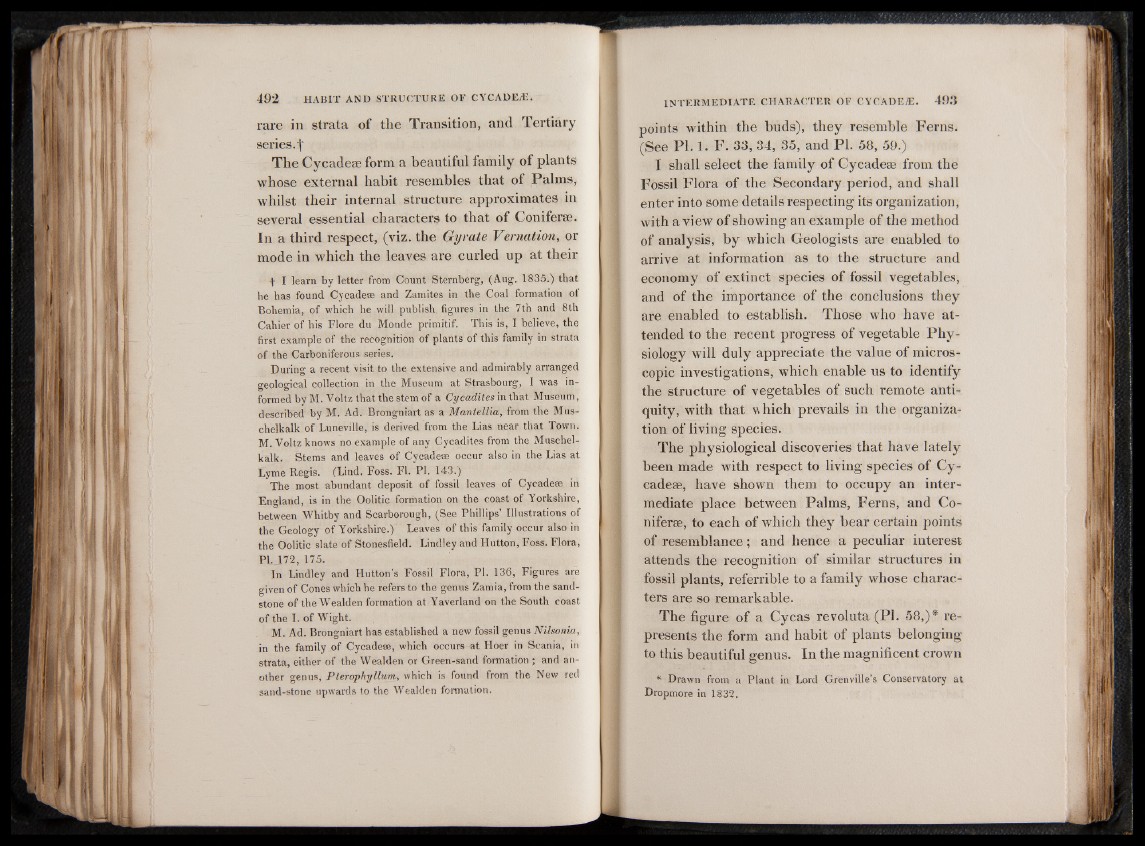
rare in strata of the Transition, and Tertiary
series.t
The Cycadese form a beautiful family of plants
whose external habit resembles that of Palms,
whilst their internal structure approximates in
several essential characters to that of Coni ferae.
In a third respect, (viz. the Gyrate Vernation, or
mode in which the leaves are curled up at their
+ I learn by letter from Count Sternberg, (Aug. 1835.) that
he has found Cycadese and Zamites in the Coal formation ot
Bohemia, of which he will publish, figures in the 7th and 8th
Cahier of his Flore du Monde primitif. This is, I believe, the
first example of the recognition of plants of this family in strata
of the Carboniferous series.
During a recent visit to the extensive and admirably arranged
geological collection in the Museum at Strasbourg, I was informed
by M. Voltz that the stem of a Cycadites in that Museum,
described by M. Ad. Brongniart as a Mantellia, from the Mus-
chelkalk of Luneville, is derived from the Lias near that Town.
M. Voltz knows no example of any Cycadites from the Muschel-
kalk. Stems and leaves of Cycadese occur also in the Lias at
Lyme Regis. (Lind. Foss. FI. PI. 143.)
The most abundant deposit of fossil leaves of Cycadese in
England, is in the Oolitic formation on the coast of Yorkshire,
between Whitby and Scarborough, (See Phillips’ Illustrations of
the Geology of Yorkshire.) Leaves of this family occur also in
the Oolitic slate of Stonesfield. Lindley and Hutton, Foss. Flora,
P1.J72, 175.
In Lindley and Hutton’s Fossil Flora, PI. 136, Figures are
given of Cones which he refers to the genus Zamia, from the sandstone
of theWealden formation at Yaverland on the South coast
of the I. of Wight.
M. Ad. Brongniart has established a new fossil genus Nilsonia,
in the family of Cycadese, which occurs at Hoer in Scania, in
strata, either of the Wealden or Green-sand formation ; and another
genus, Pterophyllum, which is found from the New red
sand-stone upwards to the Wealden formation.
points within the buds), they resemble Ferns.
(See PL 1. F. 33, 34, 35, and PI. 58, 59.)
I shall select the family of Cycadese from the
Fossil Flora of the Secondary period, and shall
enter into some details respecting its organization,
with a view of showing an example of the method
of analysis, by which Geologists are enabled to
arrive at information as to the structure and
economy of extinct species of fossil vegetables,
and of the importance of the conclusions they
are enabled to establish. Those who have attended
to the recent progress of vegetable Physiology
will duly appreciate the value of microscopic
investigations, which enable us to identify
the structure of vegetables of such remote antiquity,
with that vhich prevails in the organization
of living species.
The physiological discoveries that have lately
been made with respect to living species of Cycadeae,
have shown them to occupy an intermediate
place between Palms, Ferns, and Co-
niferae, to each of which they bear certain points
of resemblance; and hence a peculiar interest
attends the recognition of similar structures in
fossil plants, referrible to a family whose characters
are so remarkable.
The figure of a Cycas revoluta (PI. 58,)* represents
the form and habit of plants belonging
to this beautiful genus. In the magnificent crown
* Drawn from a Plant in Lord Grenville’s Conservatory at
Dropmore in 1832.